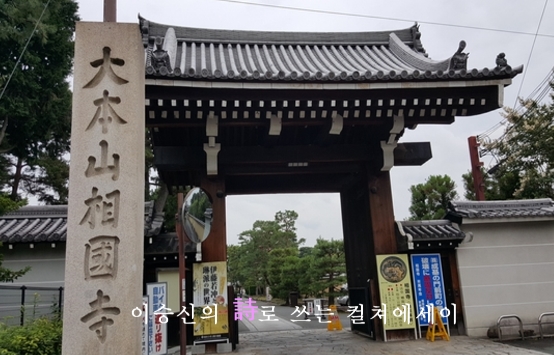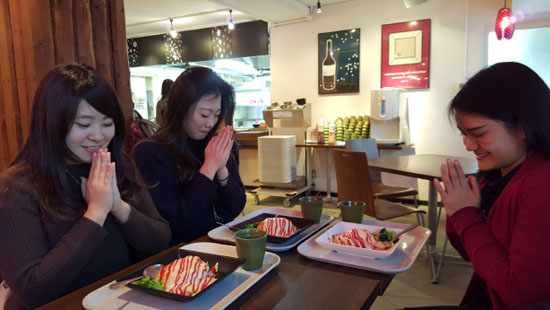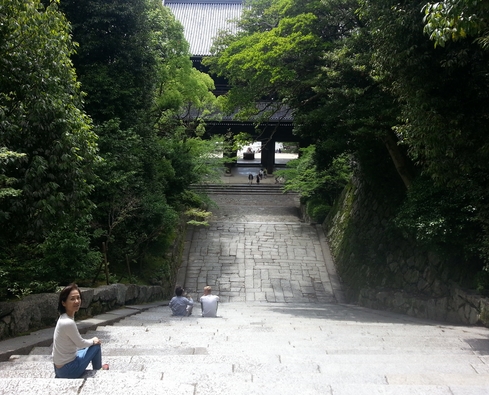Shokoku-ji temple neighboring Doshisha University 2015 11 25
Itadakimasu
The first memory of my life is being in my grandmother’s arm, praying during the evacuation period in Choryang, Busan. Everyday at 4 a.m., she prayed. She was a committed Buddhist.
Born in 1904, my grandmother made me feel proud of her, every time people compliment the outstanding beauty of her milky skin. She had a great influence in all the household affairs. It was she who made me line up for Ewha middle school when I was graduating as the top of Deoksu elementary school in Seoul. It was the time when more than twenty students in each class went to the Gyeonggi middle school on the opposite side of the elementary school. My friends told me I was in the wrong line because I would become a widow if I went to Gyeonggi. My grandmother, as well as her friends, who went to Gyeonggi all became widows due to the war and kidnapping.
Therefore my grandmother led me to go to Ewha middle school. By the influence of this Christian school, I became a Christian. In other words, my Buddhist grandmother converted me into a Christian.
Since then I have continued my religious life in the States and also back in Korea. Doshisha, where I'm studying at the moment, happens to be a Christian university and I go to its campus chapel naturally.
But I have a vivid memory of going to a Buddhist temple with my grandmother when I was very little. Once on a freezing winter day, my grandmother and I were slipping and falling down on the icy road on our way down from Doseon temple and a young man grabbed to save us. I remember my grandmother cried, 'Oh, we met a savior!' and then merrily walked down the long hillside like a little girl.
Buddhist temples are everywhere here in Kyoto. There are about two thousand five hundred big and small temples. We transmitted Buddhism to Japan in the 6th century CE and they continued their tradition for over a thousand years. Wherever they are, the temple gardens are stunningly beautiful. They are the best assets of Kyoto and tourism resources attracting the whole world.
Every time I gaze at the wooden architecture and artful gardens built by my own ancestors a thousand years ago, I wonder about how my grandmother who raised me would have appreciated this beauty. I imagine she had probably seen it since she led her newly-married life in Tokyo with my grandfather who graduated Waseda Law school in 1920s and my uncle was a director of the Information Service in Osaka in the 70s.
Kyoto was the ancient capital, which was the abode of the emperor of Japan for over a thousand years from 794 to the Meiji Restoration in 1869. All of the nineteen world heritage sites in Kyoto include Buddhist architecture and sculptures. One can call it a global Buddhist city as it embraces several thousand Buddhist temples. Since early spring of this year, I have been living in such a city contemplating such a culture.
Doshisha is the first Christian university established by Niijima o新島襄, who was the first Asian to graduate from an American college. Its campus was founded on a land grant, which was originally a part of Shokoku-ji, one of the representative temples in Kyoto where the delegation from Choseon Dynasty had stayed earlier. Numberless relics are found at the construction zone for new buildings on campus.
Shokoku-ji is neighboring the chapel of Doshisha University, and the opposite side of the university is the palace of the emperor, the head of Shinto. Shinto became a national religion since the Meiji restoration. Such a coexistence of the three religions at one region makes me contemplate on the Japanese culture and mind in many ways.
Shinto is the native religion, a kind of nature worship that pre-existed before Baekje transmitted Buddhism in the 6th century. Despite the resistance of the local power, Buddhism got settled in as a central religion of Japan thanks to the effort of prince Shyotoku who was a descendant of Baekje. Putting down its roots in Japan, Buddhism embraced the tradition of nature worship in Shinto, represented by the thought of respect for life and for environmental preservation.
During my reading class, I came across one example of this thought. Before meals, Japanese bring their palms together and say Itadakimasuいただきます (頂きます, 戴きます). I had thought it meant gratitude towards those who you are dining with, those who produced the ingredients, and those who prepared the food. It is, however, an appreciation of the spirits within the lives of the ingredients, such as meat, fish, and grains, not of the people at the same table or producers of the food. In Shintoism, it is believed that every living creature is embedded with a srit.
Tilting my head, I asked, “could it also mean the gratitude towards those who produced the food though?” A flat answer was that it does not. It seems that one cannot compare one’s effort of producing and preparing the food to the sacrificed lives. One can only cook and eat after taking precious lives, which implies that those vegetables and fish are sacrificed for our lives. Therefore, Itadakimasu means that “I take those lives and spirits,” conveying apologetic and thankful mind to the sacrificed lives and spirits. It is in line with Buddhist thought which treasures all living beings.
It is a teaching that all living beings in the world are as precious as humans and therefore it prohibits the destruction of life.
I look at all the living creatures around me one more time. It suddenly occurs to me that it is an obligation of our humankind to live peacefully along with these diverse creatures.
Kyoto is a city that makes me miss my grandmother, Chang Bok-soon, so much. As the first grandchild of hers, I was endowed with her greatest affection, ever since my grandfather, who was working at a courthouse, was kidnapped to the North during the Korean War.
Shouldn’t have become attached to the one who went away too early Ah, Grandma !
2015 November, The Buddhist Review
Itadakimas Ruins of Temple Shokoku-ji at the Ryoshinkan 良心館 of Doshisha Univ. Jionin temple 志恩院 - 2015 9 Kyoto
|









